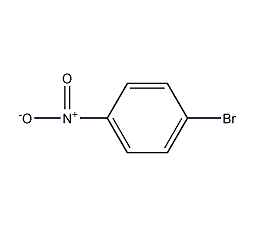
Structural formula
| Business number | 05YT |
|---|---|
| Molecular formula | C6H4BRNO2 |
| Molecular weight | 202.01 |
| label |
4-Nitrobromobenzene, p-Nitrobromobenzene, p-bromonitrobenzene, 4-nitrobromobenzene, halide, organic raw materials aromatic compounds, nitro compounds, Nitrogen-containing compounds |
Numbering system
CAS number:586-78-7
MDL number:MFCD00007280
EINECS number:209-583-8
RTECS number:CY9040550
BRN number:636964
PubChem number:24850622
Physical property data
1. Character: white crystal[1]
2. Melting point (℃): 125~127[2]
3. Boiling point (℃): 255~256[3]
4. Relative density (water = 1): 1.94[4]
5. Octanol/water partition coefficient: 2.55[5]
6. Solubility: insoluble in water, soluble in ethanol, ether, Most organic solvents such as benzene. [6]
Toxicological data
1. Acute toxicity No data available
2. Irritation No data available
Ecological data
1. Ecotoxicity No data available
2. Biodegradability No data available
3 .Non-biodegradability No information available
Molecular structure data
1. Molar refractive index: 40.48
2. Molar volume (cm3/mol): 117.4
3. Isotonic specific volume (90.2K ): 313.2
4. Surface tension (dyne/cm): 50.5
5. Polarizability (10-24cm3): 16.05
Compute chemical data
1. Reference value for hydrophobic parameter calculation (XlogP): None
2. Number of hydrogen bond donors: 0
3. Number of hydrogen bond acceptors: 2
4. Number of rotatable chemical bonds: 0
5. Number of tautomers: none
6. Topological molecule polar surface area 45.8
7. Number of heavy atoms: 10
8. Surface charge: 0
9. Complexity: 126
10. Number of isotope atoms: 0
11. Determine the number of atomic stereocenters: 0
12. Uncertain number of atomic stereocenters: 0
13. Determine the number of chemical bond stereocenters: 0
14. Number of uncertain chemical bond stereocenters: 0
15. Number of covalent bond units: 1
Properties and stability
1. Stability[7] Stable
2. Incompatible substances[8] Strong oxidizing agent, strong reducing agent, strong alkali
3. Conditions to avoid contact[9] Heating
4. Polymerization hazard[10] No polymerization
5. Decomposition products[11] �Hydrogen and nitrogen oxides
Storage method
Storage Precautions[12] Store in a cool, ventilated warehouse. Keep away from fire and heat sources. The packaging is sealed. They should be stored separately from oxidants, reducing agents, alkalis, and food chemicals, and avoid mixed storage. Equipped with the appropriate variety and quantity of fire equipment. Suitable materials should be available in the storage area to contain spills.
Synthesis method
It is derived from the nitration of bromobenzene. Add bromobenzene to the mixture of concentrated nitric acid and concentrated sulfuric acid, add it several times, and react under vigorous stirring. The temperature should not exceed 60°C. After the reaction, cool to room temperature, place it in cold water to precipitate p-bromonitrobenzene, filter, and wash with water. , recrystallized from methanol. The yield is 70%.
Purpose
Used in organic synthesis and dye intermediates. [13]


